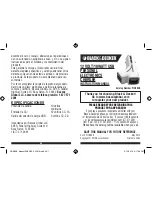
STARTING AND DRIVING
242
BRAKE SYSTEM
The tandem master cylinder brake system is a hydraulic
system with two separate sub
−
systems. If either sub
−
system
should fail, the other will still work. However, the pedal will be
harder to press, and your stopping distance will be longer.
Also, the brake system warning light may come on.
CAUTION
Do not drive your vehicle with only a single brake
system. Have your brakes fixed immediately.
Brake booster
The brake booster uses engine vacuum to power
−
assist the
brakes. If the engine should quit while you are driving, you can
bring the vehicle to a stop with normal pedal pressure. There
is enough reserved vacuum for one or two stops but no more!
CAUTION
D
Do not pump the brake pedal if the engine stalls.
Each push on the pedal uses up your reserved
vacuum.
D
Even if the power assist is completely lost, the brakes
will still work. But you will have to push the pedal
hard, much harder than normal. And your braking
distance will be longer.
Anti
−
lock brake system
The anti
−
lock brake system is designed to help prevent
lock
−
up of the wheels during a sudden braking or braking
on slippery road surfaces. This assists in providing
directional stability and steering performance of the
vehicle under these circumstances.
Effective way to press the ABS brake pedal:
When the
anti
−
lock brake system function is in action, you may feel the
brake pedal pulsating and hear a noise. In this situation, to
let the anti
−
lock brake system work for you, just hold the
brake pedal down more firmly. Do not pump the brake in a
panic stop. This will result in reduced braking performance.
The anti
−
lock brake system becomes operative after the
vehicle has accelerated to a speed in excess of approximately
10 km/h (6 mph). It stops operating when the vehicle
decelerates to a speed below approximately 5 km/h (3 mph).
Depressing the brake pedal on slippery road surfaces such as
on the manhole cover, the steel plate under the construction,
joints in the bridge, etc. on a rainy day tends to activate the
anti
−
lock brake system.
Summary of Contents for ES300 2003
Page 6: ...PICTORIAL INDEX v INSTRUMENT PANEL...
Page 8: ...PICTORIAL INDEX vii INSTRUMENT CLUSTER vehicles sold in U S A...
Page 10: ...PICTORIAL INDEX ix INSTRUMENT CLUSTER vehicles sold in Canada...
Page 14: ...PICTORIAL INDEX xiii...
Page 22: ...QUICK REFERENCE 8...
Page 60: ...SWITCHES 46...
Page 76: ...Finish GAUGES METERS AND SERVICE REMINDER INDICATORS 62...
Page 96: ...Finish INTERIOR EQUIPMENT 82...
Page 168: ...COMFORT ADJUSTMENT 154...
Page 174: ...AIR CONDITIONING 160 AUTOMATIC AIR CONDITIONING CONTROLS 20E283...
Page 176: ...AIR CONDITIONING 162 20E395 Air flow selection...
Page 234: ...AUDIO 220...
Page 262: ...STARTING AND DRIVING 248...
Page 276: ...DRIVING TIPS 262...
Page 300: ...IN CASE OF AN EMERGENCY 286...
Page 308: ...MAINTENANCE 294...
Page 316: ...INTRODUCTION 302 Make sure to place the jack correctly or your vehicle may be damaged...
Page 317: ...INTRODUCTION 303...
Page 347: ...CHASSIS 333...
Page 350: ...ELECTRICAL COMPONENTS 336 64E101 2 Engine compartment 64E102 3 Driver s side instrument panel...
















































